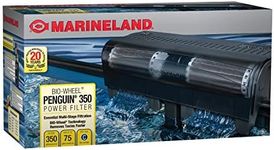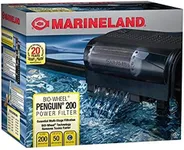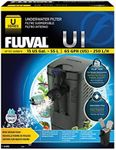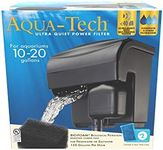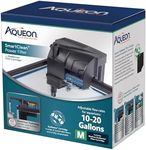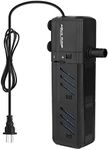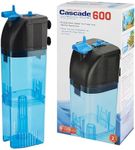Buying Guide for the Best Aquarium Filter For 10 Gallon Tank
Choosing the right aquarium filter for your 10-gallon tank is crucial for maintaining a healthy environment for your fish. A good filter will help keep the water clean, clear, and free of harmful toxins. When selecting a filter, consider the type of fish you have, the amount of maintenance you're willing to do, and the specific needs of your aquarium. Here are some key specifications to consider when choosing an aquarium filter for your 10-gallon tank.Filter TypeThere are several types of aquarium filters, including hang-on-back (HOB) filters, sponge filters, canister filters, and internal filters. Each type has its own advantages and disadvantages. HOB filters are easy to install and maintain, making them a popular choice for beginners. Sponge filters are great for small tanks and provide gentle filtration, which is ideal for delicate fish and shrimp. Canister filters offer powerful filtration and are suitable for heavily stocked tanks, but they can be more complex to set up. Internal filters are compact and fit inside the tank, making them a good option for small spaces. Choose a filter type that matches your tank setup and maintenance preferences.
Flow RateThe flow rate of a filter, measured in gallons per hour (GPH), indicates how much water the filter can process in an hour. For a 10-gallon tank, a flow rate of 40-100 GPH is generally recommended. A higher flow rate ensures better water circulation and filtration, but it can create strong currents that may stress some fish. Conversely, a lower flow rate may not provide adequate filtration. Consider the needs of your fish and the bioload of your tank when choosing the flow rate. If you have delicate fish or a lightly stocked tank, opt for a lower flow rate. For more active fish or a heavily stocked tank, a higher flow rate may be necessary.
Filtration StagesAquarium filters typically offer three stages of filtration: mechanical, chemical, and biological. Mechanical filtration removes debris and particles from the water. Chemical filtration uses activated carbon or other media to remove toxins, odors, and discoloration. Biological filtration involves beneficial bacteria that break down harmful ammonia and nitrites into less harmful nitrates. A good filter should provide all three stages of filtration to ensure a healthy and balanced aquarium. Check the filter specifications to ensure it offers comprehensive filtration. If you have a heavily stocked tank or sensitive fish, prioritize filters with robust biological filtration capabilities.
Noise LevelThe noise level of a filter can be an important consideration, especially if your aquarium is located in a quiet area like a bedroom or office. Some filters are designed to operate quietly, while others may produce noticeable noise. Read reviews and product descriptions to gauge the noise level of a filter. If noise is a concern for you, look for filters that are specifically marketed as quiet or silent. Keep in mind that proper maintenance, such as cleaning the impeller and ensuring the filter is properly assembled, can also help reduce noise.
Ease of MaintenanceRegular maintenance is essential to keep your filter functioning properly and your aquarium healthy. Some filters are easier to maintain than others, with features like easy-to-replace filter media, accessible components, and clear instructions. Consider how much time and effort you're willing to invest in maintaining your filter. If you prefer a low-maintenance option, look for filters with user-friendly designs and minimal upkeep requirements. On the other hand, if you're comfortable with more hands-on maintenance, you may have more flexibility in your filter choice.
Size and FitThe size and fit of the filter are important to ensure it works well with your 10-gallon tank. Some filters may be too large or bulky for a small tank, while others are designed specifically for smaller setups. Check the dimensions of the filter and compare them to your tank's available space. Make sure the filter will fit comfortably without obstructing other equipment or decorations. Additionally, consider the placement of the filter intake and output to ensure proper water circulation and avoid dead spots in the tank.

